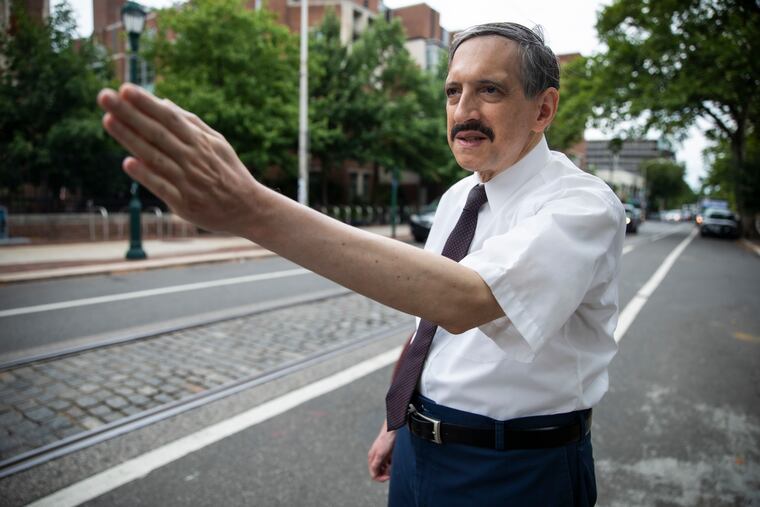A historic West Philly street, built with iconic Belgian paving stones, is being torn up as SEPTA upgrades trolley tracks
Upgraded trolley tracks have led to the removal of Belgian block in West Philly. Preservationists want to save the historic paving stones.

As they rip up worn trolley tracks on South 40th Street, construction crews have been excavating pieces of Philadelphia history.
SEPTA says safety is at stake.
But those granite paving stones, called Belgian block, helped accelerate the development of West Philadelphia into the city’s first suburb in the late 19th and early 20th centuries by enabling electrified streetcars to link Center City to an area that was then mostly rural.
Now members of the Philadelphia Street Railway Historical Society are scrambling to save the Belgian block, without gaining much traction so far. As of last week, only a small portion remained, between Locust and Spruce Streets.
“I’m still charging up the hill, but not expecting much,” said Mark D. Sanders, president of the society. “If it’s not to be, this will be just one of a long list of historical resources or artifacts lost over the years.”
Belgian block stones loosen over time, making tracks unstable and increasing the risk of a trolley derailment, which happened a little more than 15 years ago in West Philadelphia, SEPTA’s engineers say.
Once the construction crews remove the historic stones from the street, they pour concrete, used to anchor new trolley tracks, into the hole left behind.
“The way we look at it, purely from the safety standpoint, is that the Belgian block in the track area is a technology from 100-plus years ago,” said David Montvydas, chief engineer of the authority’s engineering, construction and maintenance division. “Technology improves. We’ve got a better, more resilient way of building our track now and that’s where we should be.”
Philly’s ambivalence
Despite being the birthplace of America, Philadelphia often displays an ambivalent attitude toward things in the built environment that speak to its own history.
Artifacts of Philadelphia’s past slip away all the time. The pressure of development, weak historic preservation laws, and underfunded regulators — all take a toll.
The Philadelphia Historical Commission has a staff of only four people and limited formal powers.
“It’s also tied to, at the civic level, the lack of a real embrace of our history and historical resources — in a city that’s an actual treasure trove of them,” said Amy Lambert, preservation architect and president of the University City Historical Society.
Some of the losses are well known: St. Laurentius Church in Fishtown, due for demolition this summer after years of efforts to save it; the clickety-clack of the flipping information board that once announced departures and arrivals at 30th Street Station; and the wood paving blocks of Camac Street.
Belgian block was an innovation of the post-Civil War era. Companies were able to mass produce the granite stone, cutting it into uniform rectangles. It was far superior to cobblestone, more stable and with a smoother ride — important for the electric streetcar industry.
Lambert believes the Belgian blocks on South 40th Street are worth saving. “It’s a remnant of what made West Philly grow,” she said.
The Route 40 trolley track, named for a streetcar line that was replaced by buses in 1956, borders the West Philadelphia Streetcar Suburb Historic District, listed on the National Register of Historic Places. That designation does not protect any property or resource from demolition, though it brings tax breaks for historic rehabilitation projects, Lambert said.
There is a city-designated Historic Street Paving Thematic District, designed to preserve old pavements around the city like Belgian block and vitrified brick.
SEPTA’s exemption
SEPTA says it can do this work because it owns the railroad right-of-way, up to 18 inches on either side of the rails.
The authority “claims that it is exempt from the Historical Commission’s regulation when working in the track area and the City’s Law Department agrees,” Jonathan Farnham, the PHC’s executive director, wrote in an email. The city solicitor made that ruling 15 years ago when the commission tried to stop SEPTA from removing granite-block paving from the track area on Chester Avenue, Farnham said.
State historic preservation officials said they, too, had no jurisdiction in the matter.
“If there was a room of screaming community activists demanding the Belgian block be retained and local politicians lending support, SEPTA would have to pay attention,” Sanders said. “That’s not going to happen.”
These days, Route 40 is a “diversion” route for five subway-surface trolley lines during maintenance and repair in the trolley tunnel, which is closed through July 25 for the annual summer “blitz” of work. SEPTA has, over a number of years, gradually been replacing the blocks on trolley lines.
“We’ve got a small pile of them — like a mound — up at our Midvale facility just sitting there,” SEPTA’s Montvydas said. “We know that they’re historical and we don’t want to get rid of them. But we really don’t have a use for them.”